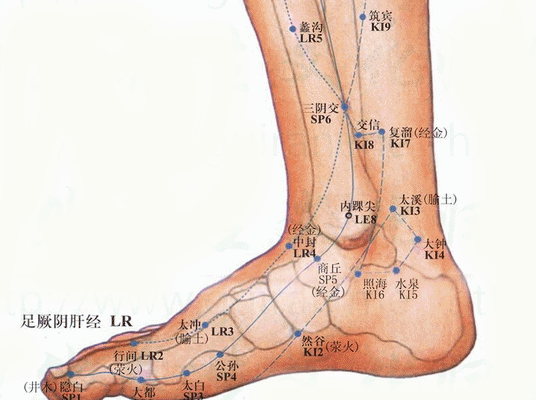The Foot Shaoyin Luo Vessel is one of the fifteen Luo vessels. According to the “Lingshu: Jingmai” (Spiritual Pivot: Channels), “The branch of the Foot Shaoyin is called Dazhong, which encircles the heel behind the ankle and diverges to the Taiyang; its branch runs along the channel to the Pericardium and descends to penetrate the lumbar spine.” This means it branches from the Dazhong point along the Foot Shaoyin channel. It encircles the heel behind the ankle and then travels towards the Taiyang channel. Another branch runs parallel to the Foot Shaoyin channel at a superficial level, ascending beneath the Pericardium and outward to penetrate the lumbar region. The conditions associated with this Luo vessel can be categorized into Qi counterflow and deficiency-excess patterns: Qi counterflow manifests as irritability and chest tightness; the excess pattern presents as urinary obstruction or dribbling; the deficiency pattern is characterized by lower back pain. The Dazhong point is used for treatment.
【Dazhong Point】

Dazhong, meaning large and small, is also associated with Tai. Zhong refers to a measuring instrument, and it also implies gathering and containing. It is a place where the essence bestowed by heaven is gathered (like a seed). Zhong is synonymous with the heel. The point is where the channel Qi is stored in the heel area, and the heel is the large bone of the foot, resembling a wine jug or bell. The heel is the back part of the foot. The point is located below the ankle joint at the heel, where the lower part is larger and the upper part smaller, and it moves flexibly, resembling a bell. The Kidney governs the pre-natal essence, which is the gathering of human essence. This point is located 0.5 cun below the Taixi point, at the inner edge of the Achilles tendon, where the Qi is abundant and gathered, hence the name Dazhong. Yang Shangshan stated: “Zhong refers to this point being the place where the Shaoyin’s major Luo branch is noted, hence it is called Dazhong.”
Location: On the inner side of the foot, below the inner ankle, in the depression at the front of the attachment of the Achilles tendon.
Method of Locating: First locate the Taixi point (while seated with feet hanging, push backward from the inner ankle to the depression between the Achilles tendon and the ankle, which is the Taixi point), measure down half a transverse fingerbreadth, then push backward to the depression to find the Dazhong point.
Functions: Tonifies the Kidney, relieves asthma, and regulates urination.
Indications: Disorders of the throat, chest, lungs, heart, and areas traversed by the channel, such as sore throat, bleeding at the root of the tongue, difficulty swallowing, coughing with blood, asthma, irritability, excessive sleepiness, dementia, malaria, lumbar pain, urinary dribbling, heel swelling and pain, throat pain, wheezing, coughing blood, heel pain, irregular menstruation, cough, hemoptysis, urinary retention, frequent urination, enuresis, constipation, lower back pain. In modern practice, the Dazhong point is also frequently used to treat bronchial asthma, neurasthenia, hysteria, schizophrenia, oral inflammation, esophageal stricture, urinary retention, and mental disorders.
Needling Technique: Insert the needle straight 0.3 to 0.5 cun, with a local sensation of soreness and distension. Do not insert deeply to avoid injuring the tibial nerve and posterior tibial artery, which could lead to movement disorders of the foot.
Moxibustion Technique: Apply moxa cones or warm needle moxibustion for 3 to 5 cones, or use moxa sticks for 5 to 10 minutes.
Massage: Pinching the Dazhong point can help prevent and treat lower back pain.

